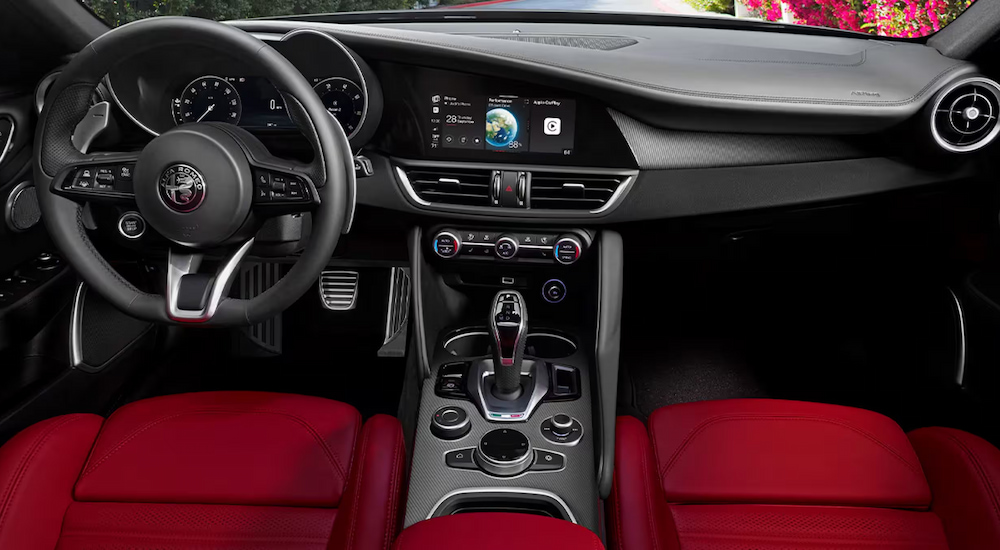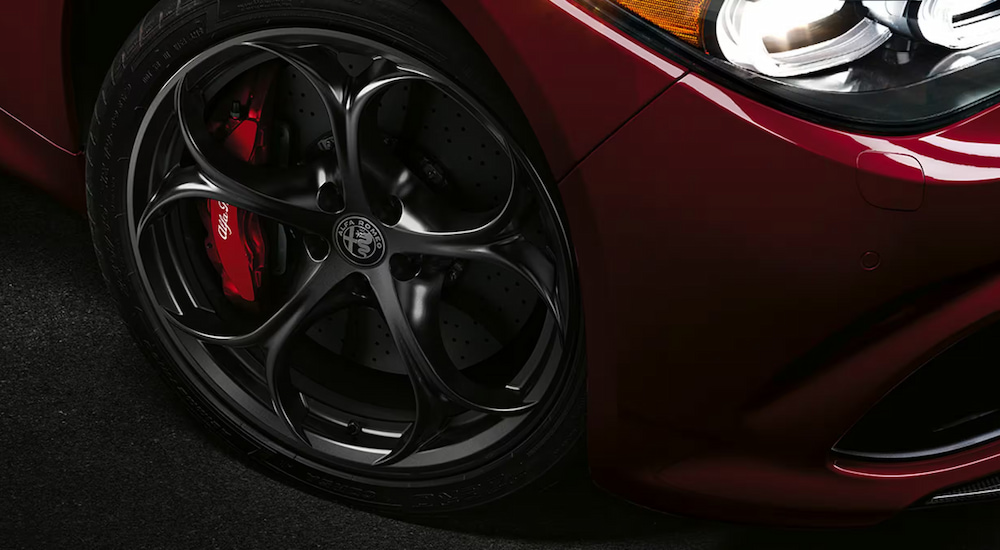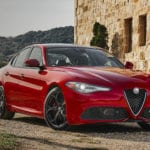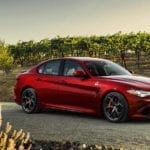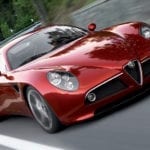Alfa Romeo has always been something of a niche brand in the United States. The Italian automaker sold just under 11,000 units in 2023, earning the company a paltry 0.07 percent market share. Still, if there was one bright spot, it would have to be the Alfa Romeo Giulia. Debuting in 2016, the rear-wheel drive sports saloon was a return to form for Alfa Romeo, encapsulating everything there is to love about the spunky Italian outfit and giving drivers an intriguing alternative to the stalwarts of the compact executive car segment. The Giulia accounted for roughly a third of Alfa Romeo’s American sales in 2023, but there are big things in the works that could see a new Giulia model hit the street by 2026.
This includes not only a new gas-powered version of the sedan but also a new EV model built on the same platform as the recently revived Dodge Charger. In a crossover-obsessed market, it’s a bold time to introduce a good old-fashioned saloon, but swimming against the current has long been the hallmark of the 100-plus-year-old Italian brand. Let’s take a closer look at the upcoming Giulia (including the high-performance Quadrifoglio version), track Alfa Romeo’s other EV ambitions, and see how the company is planning for the future in a rapidly changing auto market.
Sing a Song of Love
The new, all-electric Giulia has the potential to renew enthusiasm for the Alfa Romeo brand, but drivers will have to be patient––it has an expected debut in 2026. That will be preceded by a new gas-powered version of the Stelvio SUV in 2025 and followed by a larger crossover model akin to the Porsche Cayenne in 2027. EV versions of all three vehicles will join the lineup, with the models expected to share the same STLA Large Modular Platform found in the Dodge Charger. This unique platform has been designed to accommodate gas, electric, and hybrid powertrains, giving Alfa Romeo a little flexibility and speeding up the production time of the forthcoming vehicles.
We don’t have a ton of details regarding the next-generation Giulia, but we do have some information on the metric that’s most compelling for longtime fans of the Italian auto brand: power. Early reports indicate that the entry-level version of the new Giulia will boast around 350 hp. That’s certainly a respectable figure for the bottom of the trim ladder, but those seeking a little extra oomph might want to consider upgrading to the Veloce trim that brings a substantial 800 hp to the party.
As far as the gas-powered Giulia models are concerned, the jury is still out. The 2024 model maxes out at 280 hp, but the STLA Large platform could open up the door to improved performance as it has for the new gas-powered Dodge Charger, which offers between 420 hp and 550 hp, courtesy of its 3.0L Hurricane inline-six engine. Alfa Romeo will probably choose a smaller mill for the new Giulia in a bid to skirt China’s prohibitive tax on gas-powered vehicles with more than two liters of displacement, but only time will tell.
Then there’s the Giulia Quadrifoglio. While this is often treated as a separate model from the garden-variety Giulia, it definitely warrants a mention, thanks to the simple fact that the upcoming electric version is expected to put out 1,000 hp. Alfa Romeo’s Quadrifoglio performance brand has long served as a way to turn the company’s existing models into finely tuned high-performance machines. This approach is nothing new in the luxury market––see BMW M, Mercedes-AMG, and Lexus F––but it’s certainly made a little easier thanks to the introduction of new, all-electric powertrains and their near-limitless performance potential.
The forthcoming Giulia Quadrifoglio will likely be powered by three electric motors, including two on the rear axle and one at the front. This setup should confer some unique benefits when it comes to the car’s cornering ability, thanks to the torque-vectoring functionality made possible by the two rear motors. Torque vectoring allows each of the rear wheels to receive a different amount of torque, an attribute that can pay dividends when it comes to handling. All in all, the Giulia Quadrifoglio should be about to churn out around 1,000 hp, which is roughly twice as much as the twin-turbo V6 found in the current gas-powered model.
Long Live Alfa Romeo
For Alfa Romeo, electrification isn’t a choice; it’s a necessity. “We switch because we must,” said Alfa Romeo CEO Jean-Philippe Imparato. “If not, Alfa Romeo would be dead.” The company knows that it’ll be tough to convince drivers to make the jump to an EV if it means a significant downgrade in convenience. Charging is often cited as one of the biggest roadblocks to EV adoption, but the Giulia should be better equipped than most, thanks to its 800-volt architecture that will allow drivers to charge the battery from 10 to 80 percent in as little as 18 minutes. Imparato has indicated that the new Giulia EV will enjoy a range of around 435 miles, which is the same ballpark as the Peugeot E-3008 that rides on the STLA platform.
As far as the design is concerned, things are still a little up in the air. Previous Giulia models have employed the traditional three-box design, but the company has also indicated the sporty luxury model could embrace a new fastback design this time around. The new STLA platform actually gives Alfa Romeo a lot of flexibility when it comes to design, as it allows Alfa Romeo to change everything from wheelbase and overall length to height, width, and even suspension pickup points to accommodate different models and segments.
Take the new Dodge Charger Daytona, for example. The all-electric muscle car is over two feet longer than the current Giulia, and building the new Alfa Romeo on an identical platform would probably rile some fans who expect a more diminutive, sportier offering from the Italian brand. This isn’t really an issue, thanks to the STLA platform, which is being used on a range of Stellantis models, including brands as different as Maserati and Jeep.
The Sedan Resistance
There’s no denying the impact that crossover SUVs have had on the modern automobile market, but Imparato wants to ensure that Alfa Romeo doesn’t stray too far from its sedan-based roots. “I don’t want to give up on the sedan market. It’s in Alfa’s DNA to have a sporty sedan,” said the CEO in a recent interview. “I strongly believe that when you speak about electrification, you speak about aero, and when you speak about aero, you speak about ‘Berlina,’ or sedan,” he said.
Still, there’s no resisting the changing times. With the introduction of the forthcoming big brother to the Stelvio, four of the brand’s five core models will sit firmly in the SUV segment. In the longer term, Imparato hasn’t ruled out the return of coupe-based offerings like the bygone Brera, Spider, and 4C. “This type of silhouette will come back,” he said. “I don’t want to become an SUV brand, even if the world is switching to SUVs.”
Alfa Romeo began its EV expansion this year with the debut of the Junior, a subcompact crossover EV that was going to be called the Milano until the Italian government stepped in. The Junior will soon be joined by the Stelvio, Giulia, and the as-yet-unnamed larger SUV, setting the company up for some significant growth in the years to come. While much remains to be seen regarding the forthcoming Alfa Romeo models, one thing is for sure: it’s an exciting time to be an Alfa Romeo fan. The automaker’s renewed lineup already looks to be drawing some interest, with global shipments growing by 30 percent in 2023. Only time will tell if Alfa Romeo can grow to present a legitimate challenge to other European luxury and performance brands, but with the financial backing of Stellantis on its side, the historic brand certainly looks to be making a valiant effort.

